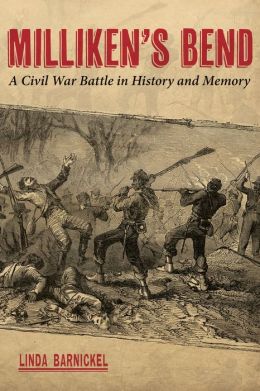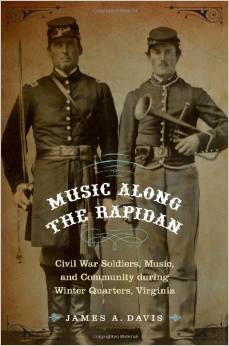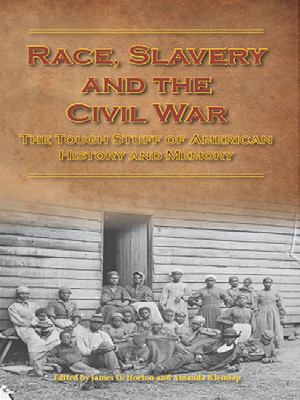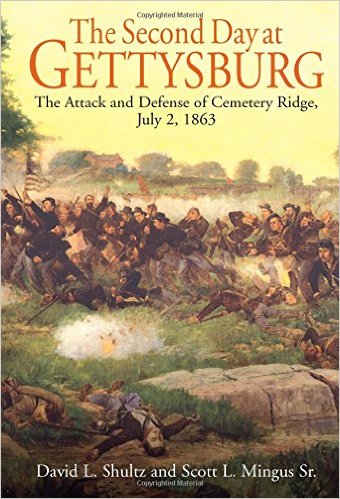Milliken’s Bend: A Civil War Battle in History and Memory by Linda Barnickel. Louisiana State University Press, 2013. Cloth, ISBN: 0807149926. $39.95.
 The past few decades have witnessed an outpouring of Civil War scholarship and more popular studies about slavery, emancipation, and in particular, the history of African American soldiers. As we make our way through the Civil War Sesquicentennial, this scholarship continues to shape and inspire a wide range of commemorative events that highlight the history of these soldiers and the contributions they made to preserving the Union and ending slavery in 1865. Indeed, the history of these men has been front and center during the Civil War 150th, which stands in sharp contrast with the Centennial celebrations of the early 1960s. Much of what we’ve seen over the past few years has been framed around a collective sense that, as a nation, we have a moral responsibility to remember and properly commemorate an aspect of our Civil War history that has been ignored for far too long, minimized, and in some cases, intentionally distorted.
The past few decades have witnessed an outpouring of Civil War scholarship and more popular studies about slavery, emancipation, and in particular, the history of African American soldiers. As we make our way through the Civil War Sesquicentennial, this scholarship continues to shape and inspire a wide range of commemorative events that highlight the history of these soldiers and the contributions they made to preserving the Union and ending slavery in 1865. Indeed, the history of these men has been front and center during the Civil War 150th, which stands in sharp contrast with the Centennial celebrations of the early 1960s. Much of what we’ve seen over the past few years has been framed around a collective sense that, as a nation, we have a moral responsibility to remember and properly commemorate an aspect of our Civil War history that has been ignored for far too long, minimized, and in some cases, intentionally distorted.
Linda Barnickel’s new study successfully rescues from obscurity the relatively unknown battle at Milliken’s Bend on June 7, 1863, in northeastern Louisiana. The battle has long been overshadowed by the larger Vicksburg and Gettysburg campaigns and the assault at Battery Wagner outside of Charleston. At the center of her story are the newly-freed slaves who served in Col. Hermann Lieb’s African brigade. Unlike other early engagements involving black soldiers, the former slaves from Louisiana and Mississippi who were present at the Bend constituted a majority of the Federal force.
Barnickel’s coverage of the battle is brief, but manages to account for every stage from the initial encounter on June 6 between Lieb’s African brigade (which included a detachment of Iowa men and the 10th Illinois Cavalry) and Confederate troops along the Tallulah railroad depot through to the bloody fighting of the following day. Continuous assaults by Brig. Gen. Henry McCullogh’s Texans on June 7 managed to push Federal units back toward a levee along the Mississippi River and may have succeeded in fully enveloping Lieb’s men, but for the presence of two Union gunboats that forced Confederate forces to withdraw to Walnut Bayou with black soldiers in pursuit.
One of the most important aspects of this book is Barnickel’s analysis of the effects of recruitment on race relations in the region and fears of servile insurrection among whites that were a constant presence both before and especially during the first half of the war as Union armies threatened local plantations and towns. While the author perhaps relies too heavily on the diary of Kate Stone to frame these fears, she does succeed in reminding readers that this battle occupied a central place in the broader story of the gradual erosion of race relations within a slave society. The author also delves into the discrimination and violence meted out by white officers and soldiers. Recruiters often impressed men into service against their wills to meet quotas and black soldiers and their families often experienced random acts of violence at the hands of enlisted men, who could not contain their rage in response to the new policy of black enlistment.
Barnickel’s analysis of growing concerns surrounding slave insurrections in northeastern Louisiana also informs another important aspect of the book: the question of whether any men in the African brigade and/or their white officers were massacred after the battle. A growing body of scholarship has demonstrated conclusively that massacres of black Union soldiers occurred on more than one Civil War battlefield, including Fort Pillow, Tennessee, and at the Crater outside Petersburg, Virginia. Confederate soldiers as well as their political leaders were incapable of viewing these men as anything other than slaves engaged in servile insurrection. However, after a close examination of the wartime record, Barnickel is unable to draw any firm conclusions. The closest she comes is to suggest that following the fall of Vicksburg a few of the captured white officers and enlisted men may have been executed after falling into the hands of undisciplined Confederate cavalry units (135-36).
The final section of the book explores the memory of the battle. Barnickel traces the few postwar accounts of the battle and teases out some of the lingering confusion surrounding the question of whether a massacre took place. In the end, she concludes that authors who posited a massacre likely confused it with other engagements. Although the author demonstrates – in contrast with David Blight’s popular thesis – that early postwar accounts of the battle did not entirely ignore black participation in the battle or their place within the broader story of emancipation, the story of Milliken’s Bend has remained relatively obscure. At the top of the list is the fact that the battlefield itself is no longer extant. According to Barnickel, poverty and a general lack of interest in the communities near the Bend are also to blame as is the area’s proximity to Vicksburg itself, which has the strongest hold on the region’s heritage tourism. While the National Park Service has recently expanded its interpretation of the campaign to include references to Milliken’s Bend in its educational and cultural assets at Vicksburg, it is likely that the battle will remain on the sidelines.
Barnickel clearly wants her readers to remember Milliken’s Bend, but the central question that is left unanswered in this final chapter is how the battle ought to be remembered. How should public historians and those involved in commemorative activities handle the issue of whether a massacre took place? This issue is incredibly divisive even in cases where massacres are well documented. Certainly, remembering the men who served in the African brigade and other units as well as what their stories tell us about the broader war in the summer of 1863 is not only appropriate, but essential. With the publication of this book, Linda Barnickel has helped us to take a giant leap forward toward achieving that goal.
Kevin M. Levin teaches history at Gann Academy in Waltham, MA. He is the author of Remembering the Battle of the Crater: War as Murder (2012) and can be found online at Civil War Memory.




